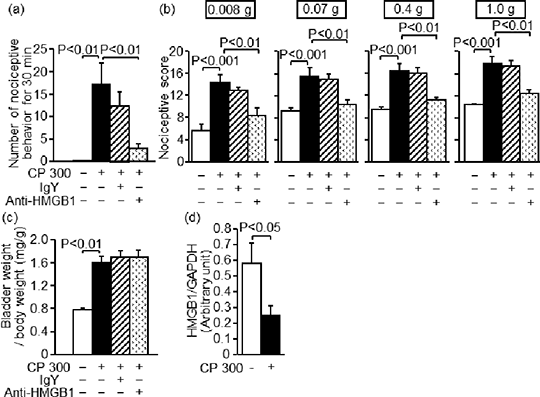Involvement of high mobility group box 1 in cyclophosphamide-induced cystitis-related bladder pain in mice High mobility group box 1 (HMGB1), a nuclear protein, is released from damaged cells and/or secreted by certain cells during inflammation. HMGB1 is now considered to participate in pain processing (1), in addition to inflammation (2). The aim of this study was to ask if HMGB1 plays a role in cystitis-related bladder pain in mice. Adult female ddY mice (n=6-8) were injected i.p. with cyclophosphamide (CP) at 300 mg/kg. Bladder pain-like nociceptive behaviour was counted 3.5-4 h after CP treatment, followed by evaluation of referred hyperalgesia with the von Frey test. The anti-HMGB1 neutralizing chicken antibody (Anti-HMGB1) or the control IgY at 2 mg/kg was administered i.p. 30 min before CP. The isolated bladder was weighed, and used for Western blot analysis of HMGB1. Anti-HMGB1 prevented the CP-induced nociceptive behaviour (Fig.1a) and referred hyperalgesia (Fig.1b), but did not affect the increased bladder weight, an indicator of oedema (Fig.1c). CP treatment resulted in decreased levels of HMGB1 protein in the bladder tissue (Fig.1d). Fig. 1 CP-induced bladder pain-like nociceptive behaviour (a), referred hyperalgesia (b), bladder weight increase (c) or decreased levels of bladder HMGB1 (d) in mice treated with Anti-HMGB1 or not. 
In summary, neutralization of HMGB1 prevented the bladder pain/referred hyperalgesia, but not bladder weight increase, caused by CP. These data suggest that endogenously released HMGB1 contributes to CP-induced bladder pain, but not oedema, resulting in the loss of HMGB1 in the bladder tissue. (1) Feldman P, Due MR, Ripsch MS et al. (2012) J Neuroinflammation 9: 180. (2) Yanai H, Ban T, Taniguchi T (2012) Trends Immunol 33: 633-640
|


